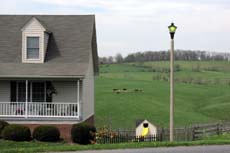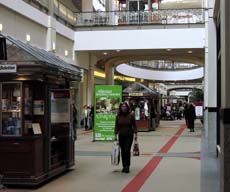Snyder on new urban form

Rural sprawl in Virginia

At the mall (Providence Place)

South Miami Beach
The focus on the characteristics of sprawl as symptoms of urban form run amok presupposes an absolute form for urban life and prevents us from seeing a new urban order. The geographer Pierce Lewis describes this new form as traditional urban elements held together by mutual attraction, but with large empty spaces in between. This is the post-World War II landscape, the contemporary city. It includes all the functions of urban life--consumption, production, residential, and social--in a loose arrangement that allows for a plurality of choice in defining the spatial patterns that make up each resident's mode of life.
It does, however, lack the single jurisdictional authority typical of more-traditional cities with distinct boundaries. Unlike a centralized city--in which zoning and planning can optimize location, uses, and densities--the contemporary city spans political boundaries with abandon. The authority of exactly where the city begins and ends, once held by municipal officials, has in fact shifted to the consumer of individual spatial patterns made possible by technology and physical and social mobility.
Today we live at multiple scales. The communities we belong to are as numerous as the choices available. Many seek to legislate aesthetics and physical form, but it is a fallacy to think that this would in fact homogenize modes of life or stop the evolution of new economic footprints for business. The culture of everyday life is implicitly spatial and implicitly dynamic. It is constantly being remade, responsive simultaneously to internal local forces and external distant forces.
Lack of understanding of contemporary urban life, and hence its form, leads us to condemn places that don't fit the prevailing paradigm. The values that have given rise to the debate about goals for livable communities and a balance of environmental and market systems are reflections of the same contemporary forces creating today's urban fabric and are not mutually exclusive. The discussion of sprawl will not advance until we recognize the underlying forces and the new patterns they create. Snyder 1999, B3, B11